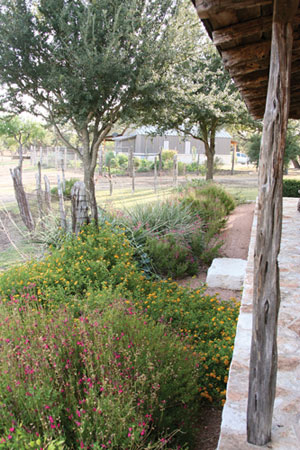
Colorful drought-tolerant perennials and ornamental grasses line a crushed granite footpath on the Diamond Y Ranch near Stonewall, Texas. The ranch is owned by Capital Farm Credit customers Dennis and Lynn Yeager.
Photo by Janet Hunter
It’s been a tough year, weather-wise, all across the South and Southwest. Too much rain in some areas has led to epic flooding, while not enough in others has resulted in extraordinary drought. Depending on the location, winter brought record-setting cold, spring a seemingly relentless wave of tornadoes, summer record-shattering heat, and fall a continuing threat of wildfires. Throw in some dust storms, baseball-sized hail, straight-line winds and even a couple of earthquakes, and it seems as though Mother Nature has been in an especially foul mood of late.
Among the consequences of extreme weather is the havoc it wreaks on our home landscapes. Trees, shrubs, ornamentals and lawns all suffer when growing conditions turn harsh, and in the end even carefully tended vegetation might not survive. The damage may be so severe that it could be necessary to start over. It’s enough to make the most determined plant lover despair.
Before you decide to give up and pave your entire yard, remember that every problem holds a gift. This just might be the time to rethink your landscape in order to make it safer, smarter, easier to care for and more able to withstand nature’s caprices. A good landscape adds “road appeal” and significant value to your country home, whether you intend to stay there for the rest of your life or put it on the market next month.
Following are some factors to consider, whether you’re reviving what’s still alive, replacing a few plants or re-establishing your entire landscape.
Adding Road Appeal
Does good landscaping really add value to a country property?
“Oh, absolutely!” exclaims Reagan Bownds, a Capital Farm Creditappraiser based in Mason, Texas. “Road appeal is one of the primary factors that drives the sale of rural property these days. Over the past 10 years, we’ve seen the country real estate market change from agriculture-based sales to more recreation/retirement sales. A good landscape is a big part of what attracts those buyers.
“People are looking for property that looks nice,” Bownds continues. “Out here where we are, the drought has really taken a toll on trees especially, and people who are re-landscaping as a result will need to do some selective brush clearing to get rid of trees that are dead or dying. Now would also be a good time to rework a stock tank to enlarge it or line it to make sure it will hold water when the rains do come back, because a good water feature is a big enhancement to a property.
“Another feature that really adds value to a rural property is a nice entrance — those are really popular now. Landscaping around buildings is also important. People are looking for a place that looks appealing and that hopefully doesn’t require too much maintenance,” says Bownds.
“It’s hard to put a dollar value on landscaping, but I can tell you that it is a big contributor to the sale of a rural property,” he says.
Strengthen your soil.
Healthy soil not only yields healthy plants, but also controls erosion, reduces the need for water and chemicals, and improves water quality. If you intend to replant, have the soil tested to determine your soil type and pH. Your local Extension office can tell you how to collect a soil sample and where to send it for analysis. Whether your soil is sandy or full of clay, adding compost or other organic materials will increase microbial activity, improve soil texture and add necessary nutrients. Then add a blanket of mulch around your plantings to stabilize the soil temperature, help prevent runoff, reduce competition from weeds and retain soil moisture.
Go native.
Every locale has its own soil types, water availability and growing conditions. Native plant specialist Sally Wasowski, writing in The American Gardener magazine, states that, “Native plants should be defined as those that have evolved and adapted to a specific location and have remained genetically unaltered by humans.” Native plants and adaptives — those that have proved to behave like natives — are the ones that can best withstand whatever Mother Nature throws at them. By incorporating natives into your landscape, you’ll be working with nature, rather than against it. Natives provide habitat for birds and other wildlife, encourage biodiversity, and help establish a visual sense of place. As Lady Bird Johnson famously said, native plants “give us a sense of where we are in this great land of ours.”
Be fire-wise.
Consider how to make your home safer from the threat of wildfires. Your primary goal here is fuel reduction. The National Fire Protection Association encourages homeowners to implement a series of defensive landscape fire-wise zones around the home. While there is no such thing as a fireproof plant, some are more fire-resistant than others. Deciduous plants generally present a lesser fire hazard (assuming they are not full of dead branches) than evergreens. With volatile oils in their leaves and needles, conifers, hollies and rosemary are highly flammable. Plant choice, plant spacing and regular maintenance can make a big difference when it comes to fire safety near your home.
Be water-wise.
A water-wise landscape is functional and easy to maintain, conserves water and can be attractive, too. Reducing the amount of thirsty turf grass, using native plants, improving your soil, mulching and grouping plants with similar water requirements can all lead to a more water-wise landscape. You also can reduce water usage by using drip irrigation and soaker hoses rather than conventional sprinklers; avoiding hand watering, which usually doesn’t penetrate beyond the top inch of soil; watering early in the morning when the evaporation rate is lower and winds are calmer; and making sure sprinkler systems are positioned properly to avoid overspray and runoff.
Grow a smaller, healthier lawn.
Up to 70 percent of residential water in the United States is used on lawns. If your lawn is dead, consider reducing its size and replacing it with a more water-efficient type of turf grass. Check with your local Extension agent for a list of appropriate grasses for your area. For a healthier lawn, water slowly and deeply once a week in summer to encourage a stronger root system. In spring, add a thin layer of compost to your lawn, rather than chemical fertilizers. Keep your mower blades sharp, mow to the proper height (no more than one-third the length of the grass), and leave the grass clippings on the ground to add nitrogen to the soil.
Consider your hardscape.
Pathways, patios, decks, retaining walls, ponds, stock tanks and other non-living elements provide visual appeal and add definition to your outdoor living space. Hardscape components also reduce the amount of vegetation that needs to be maintained, thereby conserving water, reducing energy requirements and even contributing to the fire resistance of your home. – Suzanne Labry
Raining Roses

Photo courtesy of Nell Rains
Despite her surname, Nell Rains knows a thing or two about drought. The third-generation farmer and longtime Capital Farm Credit customer owns farmland in Swisher and Hale counties in the Texas Panhandle, and her son and husband farm an additional 3,000 acres. She has seen her share of bone-dry weather, dust storms, blazing heat, freezing cold and gale-force winds. Now retired from active farming, she nevertheless maintains her passion for growing things.
“When my first husband passed away, I found solace in the soil — it helped me to mend,” Rains says. “I still find that my real interest is digging in the dirt.”
A certified Texas Master Gardener, Rains is an Earth-Kind Landscape Team member. Earth-Kind is a Texas A&M University program that uses research-proven landscaping and gardening techniques that preserve and protect the environment.
Rains specializes in Earth-Kind roses, cultivars that have been awarded a special designation from the Texas AgriLife Extension Service after having demonstrated superior pest tolerance and outstanding landscape performance, during years of research and field trials. She tests roses for the program and has assisted the creator, Dr. Steve George, with various trials. She is currently involved with a research project for the University of Wisconsin studying the effects of heat, wind and black spot on northern roses.
Earlier this year, Rains helped install a planting of all 23 Earth-Kind rose varieties at the Lubbock Arboretum as part of its 50th anniversary celebration — the farthest west planting of the cultivars to date. The roses are doing well, despite the unprecedented drought conditions. “The Texas Panhandle is a harsh environment,” says Rains. “Plants — as well as folks — have to be tough to survive here.
“I apply Earth-Kind Landscape management techniques to every area of my landscape,” she continues. “Everything gets compost and proper mulch. I planted soil conservation trees 30 years ago by this method, and they have survived the drought unscathed. My lawn areas consist of buffalo grass, Bermuda and bluegrass/fescue mix in shade areas. I grow everything from peonies to Berlandiera [a wildflower]; drought-tolerant sages to crape myrtles.”
Rains’ property is proof positive that it is possible to maintain a beautiful landscape even under the toughest of conditions. She readily shares some secrets of her success:
- Select plants that will grow in your area.
- Choose the best planting site. Considerations are sun exposure and air circulation.
- Have your soil tested and make improvements based upon the recommendations from the analysis. Add organic matter to the soil to improve its structure, improve drainage and avoid root rot.
- Improve what you have. Don’t bring in soil that might contain unknown pesticides and hidden weed problems.
- If your soil quality is poor, try raised beds.
- Mulch, mulch, mulch! Top-dress all exposed soil with 4 inches of organic mulch, which adds nutrients to the soil, helps the soil retain moisture and controls annual weeds as it decomposes. Use gravel mulch around xeric plants such as cactus and lavender.
- In the landscape, group together plants that have similar requirements.
- Water on an as-needed basis. Stick a finger deep into the soil to see when to water. Water deeply, but avoid watering at night, which increases fungal diseases. Don’t forget winter watering.
- In all extremes, monitor closely. Heat and wind can quickly affect plants.
Resources
Rock, mulch, and hardy perennials and shrubs create a low-maintenance border surrounding the Diamond Y’s main ranch house.
For information on fire-wise landscaping, visit the National Fire Protection Association website, or see the Texas Forest Service’s publication on the topic. Your local Extension office can provide information on suitable plants.
The Lady Bird Johnson Wildflower Center lists native species by state on its Native Plant Information Network.
Alabama • Alabama Cooperative Extension System, Alabama A&M University and Auburn University together produced a publication, Alabama Smart Yards.
Louisiana • The LSU AgCenter Extension Service has developed the Louisiana Yards & Neighborhoods (LYN) Program, focusing on landscapes that minimize environmental damage, conserve water, reduce storm runoff and enhance desirable wildlife habitats.
Mississippi • Mississippi State University offers all sorts of information about creating sustainable landscapes and gardens.
New Mexico • The Native Plant Society of New Mexico provides a list of plants and information about sustainable landscapes for New Mexico.
Texas • The Texas AgriLife Extension Service offers landscaping information. The Earth-Kind section is especially pertinent.